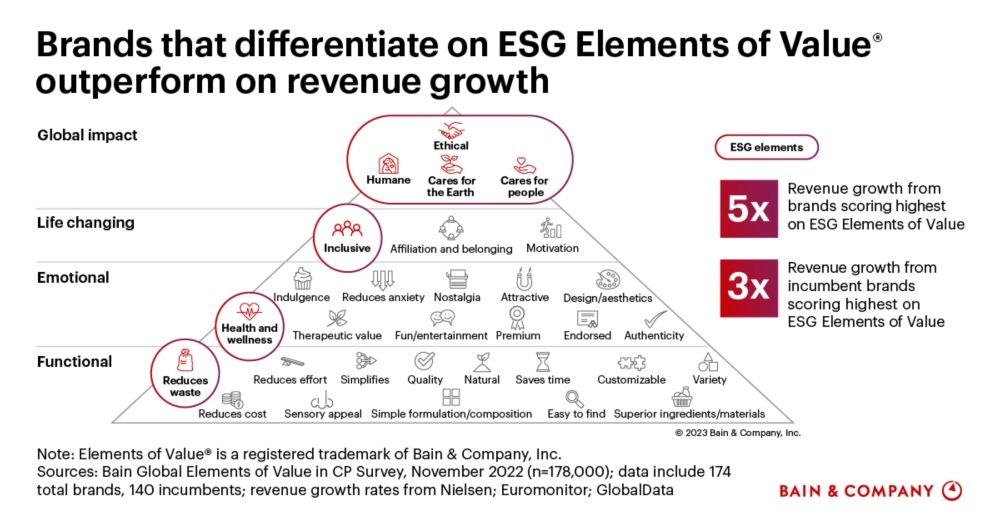Research by Bain & Company shows that brands which scored highest on the seven sustainability elements achieved five times greater revenue growth compared to those with the lowest scores.
Survey shows that ESG has become a top-three key purchasing criterion for over half of consumers across the globe
JUST how vital is a brand’s purpose to consumers?
Environmental, social and corporate governance (ESG) concern is no longer a demand from a niche minority; it has become a top-three key purchasing criterion for more than half of consumers globally, according to our recent survey of nearly 200,000 consumers in four countries and nine consumer categories.
Another significant finding with big implications for consumer goods companies is that consumers are personally “divesting” from brands with poor diversity, equity and inclusion (DEI) and social track records.
To grasp consumer value perception, in 2015, we identified 30 fundamental types of value known as Elements of Value (See Figure 1).
These are categorised into four groups: functional, emotional, life-changing and global impact.
The Elements of Value (EOV) pyramid offers a data-driven approach for companies to assess the value consumers derive from their brands compared to others.
While EOV focuses on brand differentiation, metrics like brand awareness and brand power address brand salience. Emphasising both is essential for superior brand growth.
We have continually monitored consumer behaviour and adapted our EOV to reflect changing attitudes. As consumers now prioritise how products and services make them feel and their impact on the world, companies must incorporate higher-purpose elements like ethics, environmental responsibility and inclusivity.
Bain has responded by periodically revising the EOV, using advanced statistical methods. We’ve replaced some elements and introduced seven vital sustainability-related values. This update enables companies to gauge their ability to meet consumers’ growing emphasis on these values effectively.
Our research confirms that delivering these elements positively impacts business outcomes. Brands meeting basic functional needs like “quality” and “sensory appeal” do well, but those delivering more elements enjoy better growth, penetration and repurchase rates. This effect is amplified when companies excel in higher- order values.
In our research, brands that scored highest on the seven sustainability elements achieved five times greater revenue growth compared to those with the lowest scores. Among incumbents, the revenue growth was three times better than competitors scoring the lowest on sustainability elements.
The message is clear: There’s a sizable opportunity for consumer goods companies to capture consumer interest in higher-purpose types of value.
Four measures can lead companies in that direction:
> Ensure fundamental competencies: To gain from differentiation through EOV, brands must meet essential requirements, which can vary by product category, such as “sensory appeal” in soft drinks or “quality” in body lotions. Depending on the brand’s value proposition, addressing “cost reduction” or “risk reduction” may take precedence over “inclusive” or “humane” elements.
> Identify optimal differentiation opportunities: Once table stakes are delivered, brands can strategise differentiation across ESG and other factors. Competition in higher-order EOV varies by category and location, depending on the sustainability practices already present.
> Drive growth with targeted actions and messaging for consumer segments: Different consumer segments perceive distinct values within the same brands. The digital media shift has reshaped brand marketing, offering access to valuable consumer data and enabling companies to emphasise different brand aspects for specific segments, unlocking growth opportunities. Insurgent brands effectively unlock value by tailoring actions and messaging to specific segments. For insurgents and incumbents alike, a purpose-related brand strategy must go beyond communication to include meaningful actions to avoid consumer rejection.
> Experiment extensively: In a hyper-fragmented and competitive consumer environment, experimentation is the key to building out and activating a purpose-focused brand. It helps brands identify consumer preferences, refine sustainability initiatives, messaging and visuals, tailoring resources for specific audiences, and guiding ESG marketing investments. For instance, a food company revamped its core product, once seen as unnatural and unhealthy, through experimentation. They relaunched it as 100% plant-based, emphasising health and environmental benefits, resulting in a 3% sales growth from a previous -3% to -6% decline.
Yet, as our refinement of the EOV suggests, consumer tastes and needs continually change, and companies need to be prepared to shift their strategy as those changes occur—and do it before the competition. Early movers on higher-order EOV can outperform, according to our research, but brands must continue to differentiate to sustain their growth.
To see how companies successfully keep raising the bar, consider the thoughtful moves taken by Lululemon.
The apparel retailer’s shift towards inclusivity, affiliation, belonging and motivation helped it gain 1.5 percentage points in the sports apparel market from 2016 to 2021, taking market share from United States competitors while continually raising the bar.
Therefore, continuous experimentation to align with evolving consumer values is vital for brands committed to delivering differentiated higher-purpose value and staying ahead of competitors.
Zara Lightowler is an associate partner at Bain & Company based in Kuala Lumpur, Philip Dowling is a partner based in Munich and Harry Morrison is a partner based in London. The views expressed here are the writers’ own.









